John Anderson Campus
The John Anderson Campus, the main campus of The University of Strathclyde, is located in Glasgow, Scotland. The campus is self-contained in its own area which straddles the Townhead and Merchant City districts on the north eastern side of the city centre, while being only minutes from the M8 Motorway, George Square and is located midway between Queen Street Railway Station and High Street station on the North Clyde Line. .
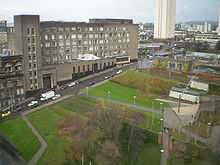
History
The John Anderson Campus was originally the only site of Strathclyde University, as the Jordanhill Campus did not become a part of the University until it incorporated Jordanhill College of Education in 1993. The campus is named after John H. D. Anderson (1726–1796), a former Professor of Natural Philosophy at the University of Glasgow, who left instructions in his will describing a "a place of useful learning for the good of mankind and the improvement of science"- a second University for Glasgow that would teach practical subjects and which was also to be appealing to people normally left out of the university system (at the time, particularly women and craftsmen from the city) and a university which wouldn't discriminate against someone because of their religion, race or gender. Originally named Anderson's Institution (which was established in 1796), the University was renamed to Anderson's University in 1828, partially to fulfil Anderson's vision of two universities in the city of Glasgow. In 1877, it was forced to remove the title of 'University' as it lacked a Royal Warrant to do so - becoming Anderson's College.
Ten years later in 1887 it merged with the Allan Glen's School to become the Glasgow & West of Scotland Technical College. In 1912, the technical college was renamed the Royal Technical College and became the Royal College of Science and Technology in 1956. It joined with the Scottish College of Commerce in 1964 - later the same year, the merged institution became the University of Strathclyde[1][2] as it is still known today.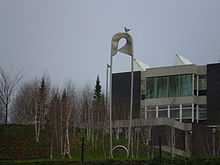
Large sections of the campus are built on and around grounds which once contained the Glasgow Royal Maternity Hospital. Following the 1940s Bruce Report, Townhead was designated a Comprehensive Development Area (CDA), and much slum housing was demolished. Some of the reclaimed land was rezoned for educational purposes in anticipation of the Royal College's growth into a university. The first of the modern-era buildings to be constructed were the Student's Union, James Weir and Thomas Graham buildings at the turn of the 1960s.
The 1960s and 1970s saw a huge programme of new academic buildings being built, and in line with contemporary fashion at the time with other university expansion programmes of the period many of these buildings were built in the distinctive (and controversial) Brutalist architectural style – the McCance (1964), Stenhouse (1974) and Architecture Buildings (1966) all being good examples of this. The 1980s concentrated on developing the student residences. Below is a synopsis of the campus history, along with the current occupiers of each building in brackets:
- 1912 Completion of Royal College Building
- 1958 James Weir Building (Mechanical, Design, Chemical and Manufacturing Engineering) – extended in 1960.
- 1959 Students' Union Building
- 1959 Opening of Marland House by the General Post Office. Would later become the Graham Hills Building.
- 1962 Thomas Graham Building (Chemistry)
- 1963 McCance Building (Houses central administration, History, Politics, Registry)
- 1965 Livingstone Tower (Mathematics, Statistics, Languages and Computer Sciences(CIS) )
- 1966 Architecture Building
- 1967 Colville Building (Civil Engineering, Metallurgy, Physics)
- 1971 John Anderson Building (Physics, Civil Engineering)
- 1972 Wolfson Centre (Bioengineering), Birkbeck Court residences
- 1973 Collins Building (Collins Gallery, Senate/Court suites)
- 1973 Stenhouse Building (Law)
- 1974 Construction of the Callanish sculpture and landscaped area (popularly known as "Steelhenge")
- 1975 University Centre (Refectory, Staff Club, Sports Centre)
- 1976 Todd Centre (Pharmacology)
- 1977 William Duncan Building (Strathclyde Business School)
- 1981 Curran Building created from former Collins warehouse (houses Andersonian Library)
- 1983 EAC Building (later Lord Hope Building)
- 1984 Lord Todd restaurant, acquisition of the Barony Hall
- 1987 Acquisition of Marland House from British Telecom, and is later renamed Graham Hills Building.
- 1990 Opening of James Blyth and Thomas Campbell student residences
- 1991 Opening of Chancellors' Hall student residences
- 1992 Graduate Business School building opens
- 1997 Opening of James Goold Hall of Residence
- 1998 John Arbuthnott Building (Strathclyde Institute for Pharmacy and Biomedical Sciences)
- 2001 Acquisition of the Rottenrow maternity hospital site – demolition of the Glasgow Royal Maternity Hospital
- 2002 Thomas Graham Building extension completed
- 2004 Rottenrow Gardens Opened
- 2010 Hamnett Wing of the new Strathclyde Institute for Pharmacy and Biomedical Sciences building on Cathedral Street
- 2012 University of Strathclyde Technology and Innovation Centre (Under Construction)
When the maternity hospital was finally demolished in 2002, a statue in the shape of a safety pin was erected in the John Anderson campus' Rottenrow Gardens in memory of the building.
Accommodation
Strathclyde University provides accommodation for most of the first year undergraduates. The accommodation block is located on the easterly side of the John Anderson Campus. Each accommodation block is named after a famous scientist or contributor to the University of Strathclyde. Listed below are all of the accommodations on the campus, who they are named after and some basic information about the occupancy:
James Young Hall
The James Young Hall can be found next to Chancellor’s Hall at the south easterly corner of the accommodation block. The James Young Hall is one of the more expensive class of accommodation residencies which provide the luxuries of an en-suite bathroom (including showers/hand wash basin/toilet facilities) with each individual single study bedroom. These flats are available as 3, 4, 5 and even 6 person flats. The students in each flat share a spacious kitchen, as well as a living and a dining room with a tv provided. Although the rent is steep, this includes heating and lighting as well as cleaning in the shared areas which you do not get in other accommodation such as the Thomas Campbell building.[3] James Young ,who is most well-known for distilling paraffin wax from coal. His affiliation with the University started when he attended night classes at Anderson College (Strathclyde University), after being appointed assistant to Thomas Graham he worked up the academic ranks to become President of the College between 1868 and 1877 .
James Goold Hall

James Gould hall is one of the newest halls in the accommodation block. It supports 66 students, divided into 5/6/8 person flats.[4] The hall was named after James Goold due to his involvement as Chairman of the Court of Strathclyde University in the years between 1993 and 1997[5]
Murray Hall
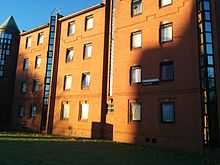
Murray Hall is located at 75 Collins Street, Glasgow G4 0NG. This is the only residence in the Campus Village which is not divided into flats. Instead, 70 students have their own study bedrooms with wash-hand basins and share a large kitchen/living/dining room plus showers and WC facilities located on each floor. There are TVs on the 2nd and 4th floors. The rent for this residence includes heating/lighting plus a cleaning service for the shared areas. The contract period last for 39 weeks from September to June. Murray Hall was named after Lord Murray of Newhaven who was given an honorary degree in 1973. His full name is Keith Anderson Hope Murray, Baron Murray of Newhaven KCB. Murray was a British academic and Rector of Lincoln College, Oxford. He became a Research Officer for the AERI, a post he held until 1944. In 1937, however, he was appointed a Fellow and Bursar of Lincoln College, Oxford, as well as being appointed by the University to Oxford City Council.
Forbes Hall

Named after George Forbes who is affiliated with the university through his appointment to professor of natural philosophy in 1873. The residence provides accommodation for 104 students. The hall is divided into 4 and 6 person’s flats. Each flat has single study bedrooms with wash-hand basin. The residents share a kitchen, living/dining room with a TV provided. Other shared facilities include shower and toilet. The Forbes accommodation lines the north side of rotten row east which cuts the accommodation site in half.
Garnett Hall

Garnett Hall lies in the north eastern most section of the accommodation area. Its three blocks have a very similar design to that of Forbes hall.[6] It provides accommodation for 124 students in 4 - 6 person flats. The origin of the name is that of Thomas Garnett, a lecturer of physics and also very committed to the educational emancipation of women[7]
James Blyth and Thomas Campbell Court
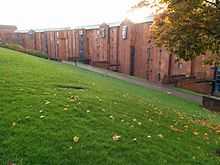
Both the James Blyth and Thomas Campbell court provide a combined accommodation for 372 students (216 in the James Blyth court, and 156 in the Thomas Campbell Court). Each flat is either a 4 or an 8 man flat, which then contains either 4 or 8 single study bedrooms. In each flat there is a centralised basic kitchen, living and dining room. There is also a shower room and toilet facilities available to all students.[8] Both buildings are located on the steep bank south of rotten row east. James Blyth was a Scottish electrical engineer and a lecturer at the Anderson College, now better known as the University of Strathclyde. He was an almost famous figure around the Anderson College, hence the reason one of the accommodation blocks are named after him. Thomas Campbell was a Scottish poet who was known as one of the men behind the idea of London University. He was born in Glasgow in 1777 and died in Boulogne, France in 1844.
Chancellors Hall

Chancellors Hall is located at the intersection of rotten row east and taylor street. It is the tallest accommodation allowing up to 165 spaces available for students. These are separated into 3 to 6 people per flat. Every one of these bedrooms has an en suite shower/wash-hand basin/WC. The people on each flat share a large kitchen/living/dining room and a TV is also included. Rent includes heating/lighting and also a cleaning service for the shared areas of the flat. Chancellors Hall was named after The Chancellor Rt. Hon the Lord Smith of Kelvin. Lord Smith is one of Scotland’s leading business figures and currently chairs the organising committee for the Glasgow 2014 Commonwealth Games. Lord Smith is currently chairman of SSE, Weir Group and the UK Green Investment Bank and is a non-executive director of Standard Bank Group South Africa.
Birkbeck Court
Birkbeck court is named after George Birkbeck who studied natural philosophy at the Andersonian Institution, now the University of Strathclyde. Birkbeck court is the oldest and biggest student accommodation housing three hundred and four students. The court is divided into flats each housing six students. Each student has their own small study bedroom but shares kitchen, living and dining room. Other facilities shared include shower room and toilet. Birkbeck court being the largest hall of residence there is a great deal of meeting other student from a wide range of cultures and backgrounds. The court is also near other leisure facilities being very close Glasgow City which is only 5 minutes’ walk. Birkbeck court is located in the north west corner of the accommodation block.
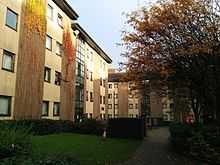
The Lord Todd

The Lord Todd Building resides in the centre of the accommodation block. It serves as the village office, one of the many laundry facilities, a café and local pub. The village Office deals with any maintenance or accommodation issues and reroutes all post for the accommodation buildings. The café has recently had a facelift and rebrand to Aroma.[9] Todd’s Bar is a gives a more traditional feel compared to that of the Student Union, it runs pub quizzes and is a favourite for many students
Future & Development plans
The Jordanhill campus is currently the location of the university's faculty of education, which is to be moved to a new building on the John Anderson Campus. The building is 14,500 sq metres and will be able to support 2,500 students. It is expected to be completed by 2010.[10]
External links
References
- ↑ http://www.strath.ac.uk/about/heritage/
- ↑ http://phys.strath.ac.uk/information/history/photos.php
- ↑ http://www.strath.ac.uk/accommodation/ouraccommodation/campusvillage/jamesyounghall/
- ↑ http://www.strath.ac.uk/accommodation/ouraccommodation/campusvillage/jamesgooldhall/
- ↑ http://www.independent.co.uk/news/people/obituary-lord-goold-1253414.html
- ↑ http://www.strath.ac.uk/accommodation/ouraccommodation/campusvillage/garnetthall/
- ↑ http://www.strath.ac.uk/archives/iotm/june2012/
- ↑ http://www.strath.ac.uk/accommodation/ouraccommodation/campusvillage/jamesblythcourt/
- ↑ http://www.strath.ac.uk/yousaidwedid/
- ↑ http://news.bbc.co.uk/1/hi/scotland/glasgow_and_west/5124990.stm